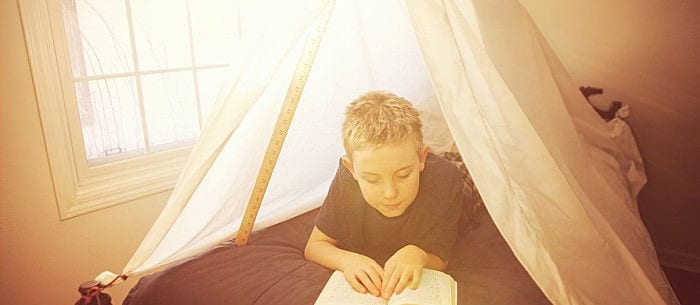Quick, what are some of your best childhood memories? Ask any adult, and it won’t be long before someone mentions forts. Making a fort is one of the best experiences a kid can have, but a great fort can’t just be thrown together — it must be thoughtfully constructed for maximum fun.
Here are 3 tips for making the process simple and easy:
- Have a Meeting of the Minds
If you want to know how to build a fort, start with inspiration. Sit down with your child and his friends to make a list of cool ideas, and don’t offer your own ideas unless your child seems stuck.Jeanie Stiles, who with her husband David own the outdoor projects site Stiles Designs and wrote “Forts for Kids,” the ultimate handbook on how to build a fort, says the next job is to scope out a good location. “Before beginning to build, choose a spot that can be reached by an electric extension cord,” says Jeanie. A good fort location has one wall or the ceiling already established. The back of the couch is a great fort wall, or your home office desk could be the start of a sturdy ceiling.
Next, sketch a rough plan. If art isn’t your forte (no pun intended), divide the duties — have one person design entrances and exits, another the dcor. Your most devious child can be in charge of fort security and booby traps, since he’ll know best how an intruder will try to approach.
- Execute
Now it’s time to gather supplies and construct your fortress. First-timers will be happy with a simple blanket draped over two chairs. In fact, that was the fort of choice for the Stiles’ daughter. “After this, she graduated to the empty refrigerator box fort, decorated with scalloped cardboard shingles and walls painted to look like stones,” says Stiles.For building materials, start with couch cushions and sheets, but be ready to branch out — literally. “The most obvious and economical source of materials is deadwood — logs, branches, etc.,” says Stiles. If you opted for a fort location that doesn’t have a ceiling, a tall broomstick or branch from the backyard will prop up a ceiling made of bedsheets quite well.
If the fort seems dark inside, Stiles recommends checking your basement for an old piece of Plexiglas to stand in for a window or skylight.
Finally, accessorize. “Pick a theme for your fort — hobbit house, pirate ship, stockade or medieval castle — and collect costumes to store in a homemade treasure chest,” says Stiles.
- Take No Prisoners
Don’t discourage your children’s wild imagination, but at the same time, think about making a fort that requires low investment and offers high reward: A simple flashlight and quick lesson on shadow puppets may keep them giggling under that fabric roof for hours. Loan the fort some potted plants and small rug for the interior, and a table lamp to make the space more realistic.Acknowledge the benefits of pretend play and enjoy the fort yourself. According to Gwen Dewar, Ph.D., founder and author of Parenting Science, the make-believe time spent building and defending a fort is not at all wasted, but very productive. “Psychologists like Daphna Buchsbaum think make-believe offers kids valuable practice in reasoning about ‘what-ifs,’ a crucial skill for solving problems and making decisions in the real world,” says Dr. Dewar. “Moreover, joint pretend play — the sort of thing we see when two or more kids play together — may teach kids important lessons in cooperation, concentration and impulse control.”
Stiles agrees. “Building a fort can help teach kids how to work together with family or friends, how to use tools, and with luck, how to cultivate housekeeping skills,” she says.
For your child, inspiration may look like rooftop water balloon launchers or Nerf guns poking out windows. But for you, knowing the developmental growth that results will be inspiration enough to perfect the art of building a kickin’ fort. So sure, help your child get started, but don’t be surprised when he says, “Mom, can you go now?” And remember to watch out for those booby traps as you leave.
Want some other fun activity ideas for your kiddos? Try these 101 things to do with kids.
Bethany Johnson, a professional writer from Washington, D.C., specializes in the quirks of family life and relationships. When she’s not writing, Bethany and her husband raise both free-range chickens and free-range children on their organic farm in the suburbs.






